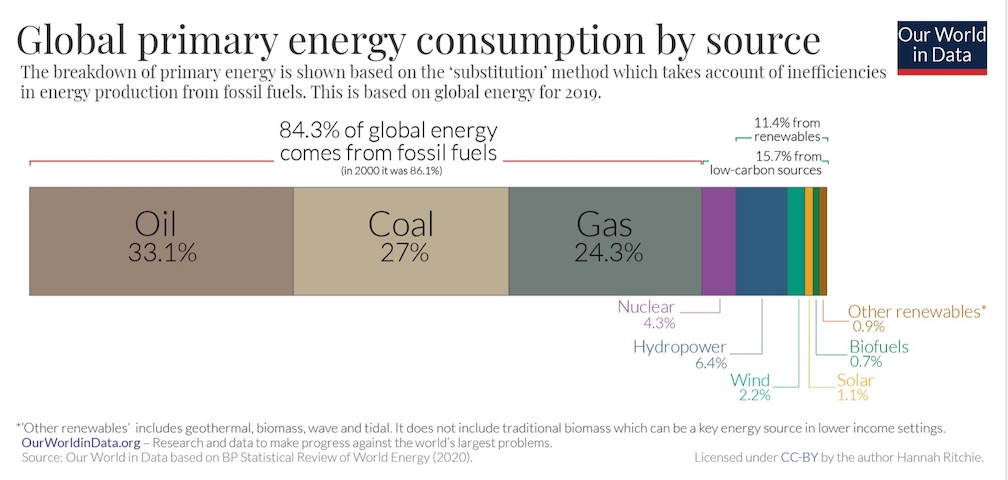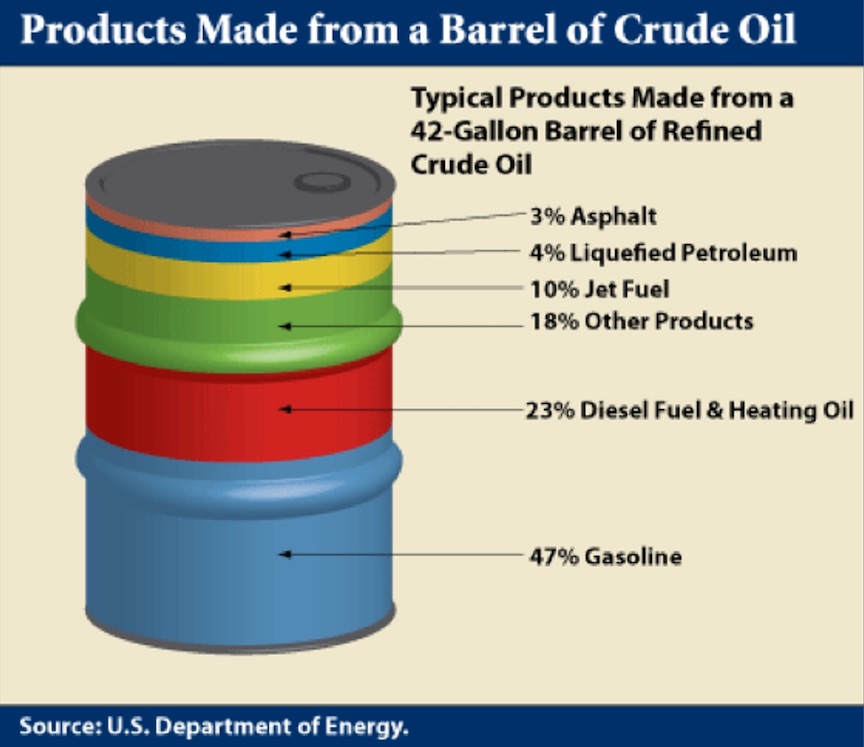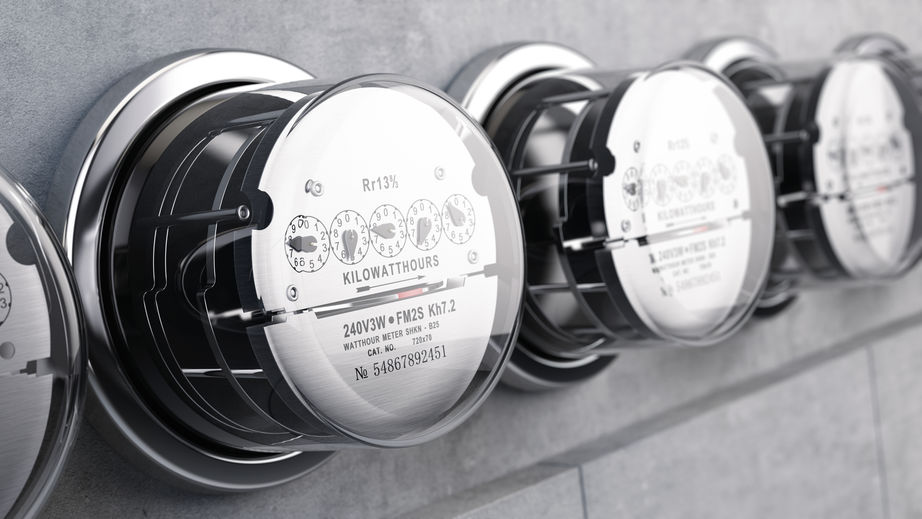By MURRAY WALSH
(Second in a four-part series.)
According to this Our World in Data, earthlings used 173,340 terawatt-hours of energy in 2019. This is an average of just under 20 TWh per hour.
What does terawatt-hour mean? A terawatt-hour is a unit of energy equal to outputting one trillion watts for one hour. It is enough energy to illuminate 10 billion 100-watt lightbulbs. In numbers it looks like this: 1,000,000,000,000.
These are big numbers and hard to ponder so let’s narrow the focus a bit. An American household uses a lot of electricity. The U.S. Energy Information Agency says the average U.S. household uses about 11,000 kilowatt hours (kWh) per year in 2019. My own house in hydro-electrically powered Juneau Alaska used 9,432 kWh in 2019. However, that is not the total energy usage. You have to include oil-fired space heat which, even in Juneau, is far less expensive than electricity for space heat and propane for the range top, barbecue grill and hot water. You also have to add in the gasoline or diesel for your vehicles. Given all that, according to the source above, the average American used about 80,000 kWh in 2019 or over 300,000 kWh for a family of four.
We also have to add in the energy it took to manufacture all of the stuff you buy, especially your house, and the energy it takes to for all the activities you do such as ride on airplanes, attend movies, and educate your children. In fact, the federal energy info agency tells us that America uses about 30,000 terawatt hours per year. Divide that by our current population of 330 million and you get about 100,000,000 Wh per person per year. (Note: we are talking watts now, not kilowatts.) Over a 100-year lifespan, that’ll be 10,000,000,000 Wh. or one percent of a terawatt hour.
You and 99 of your equally long-lived friends will use one terawatt-hour over your collective lifetimes. Makes you feel like you are part of something big, right? Well, the climate activists will say that part of the solution is for us all to live smaller, especially Americans. If we drive small cars, or better yet, take the bus; live in apartments; and eat tofu, the planet will be saved. This kind of directive, without clear and direct evidence of need, will be resisted. People could see and smell air pollution and were thus willing to do something about it. Same with other environmental issues.
Well, let’s suppose we all take the hint and decide to live small, even if only to avoid scowls from our neighbors. Let’s be bold and say we will cut our energy consumption in half. Is that enough to eliminate the need for fossil fuel energy? Nope, not by a long shot. This is the total energy picture, and 2019 year history, for our planet:

Note: It is really worth it to look at this chart at https://ourworldindata.org/energy-overview. The chart is interactive and you can look at the details year by year.
This should make it clear that fossil fuels are by far the mainstay of planetary energy consumption and that even cutting by half would still require plenty of fossil energy. Fossil fuels include the big three, oil, gas and coal but if we remember that the energy is converted, that is, made useful, by combustion, there is a fourth fuel that generates carbon emissions and that is “traditional biomass” burning such as wood, charcoal, peat, and that arid climate favorite: dung.
Interestingly, according to the above chart, the amount of biomass energy consumed per year has basically doubled since 1800. The world population, on the contrary, has increased from just under one billion people to over seven billion over that same period of time. (See OurWorldinData.org) It is probably safe to say that there are still a billion people or so that depend on burning biomass to meet their energy needs for heating and cooking but it is clear that the vast majority depend on the other three fossil fuels for their energy needs.
Again, the point of this series is to highlight the nature and necessity of the fossil fuel industry and to demonstrate the folly of seeking to destroy it without a competitive alternative in existence. The value is not just fuel for energy but also in products and there are thousands of things made from all three types of fossil fuel. The bulk of fossil fuel is indeed used for energy but, as shown below, there is a substantial amount that goes to non-energy use.

This graphic is just for petroleum but there are similar proportions for gas (pantyhose, among other things) and coal (bowling balls, concrete and aspirin to name three.) An important point to make is that if we did not use fossil fuels for energy, we would still have to extract it to make all this other stuff and it would all cost a lot more because of the economies of scale.
I hope it is clear from all this that the world depends on fossil fuels for energy and a lot of other benefits. The day may come when a non-fossil-based energy system can evolve that is large enough to replace fossil and has none of the side effects that make them objectionable.
For a time during the 1950 – 1970 period, it was thought that nuclear power was that holy grail and it was vigorously pursued in France and some other places but cost, plant safety and anxiety over the disposal of spent fuel eventually shut down most of the industry, especially in the United States, and limited its growth around the world.
There is still hope for fusion-based electricity which would supposedly not generate any waste but the public is going to have to believe it is cost-competitive and totally safe before it will be commercially available.
What to do until that day arrives? Well, let’s figure out how to use fossil fuels to make energy, especially in the form of electricity, in a way that generates zero unwanted emissions. It is being done and we will explore those efforts in Part 3 of this series.
Murray Walsh is part of the extended MRAK writing staff in Juneau. Check back for Part 3.

Let’s just pave over everything. Use asphalt to seal nature into the ground.
Faux problem solved.
The main thing the planet needs saving from are the idiots trying to “save” it.
I reject the absurd premise that using energy endangers the planet.
…
The planet is not in danger. The planet does not need saving. The planet will be just fine with or without us.
…
If you want to save a planet, how about Neptune? Or Mercury?
The news media and our school systems have 8 year olds having anxiety attacks over this crap. I agree with MA. The lunatics in panic mode over this are completely nuts. Americans have always adapted and fixed problems. Of course as Thomas Edison told Henry Ford after he invited the lightbulb. ( technology will continue to advance until it destroys us) Mabie we are almost there.???
Nevertheless, the decision has been made to de-carbonize. Okay, fine. At the same time, we need to take out the dams. Roger, that leaves solar and wind, which take 6x more copper than traditional energy. We can’t mine copper in the US. Chile and Peru currently produce almost 40% of global supply and are having trouble bringing on new projects. So we are seeing huge “greenflation” in copper as well as aluminum and iron. We produce more power from nukes than anyone, but nuclear energy accounts for only 20% of our electricity. That will probably need to increase.
So we need to reduce energy consumption so we can reduce energy creation. Since people are the consumers, I suppose we need to reduce the number of people. How about we just make up a story about how bad a virus is to scare everyone into taking a vaccine that increases the strength of the virus until the perfect number of people is achieved. Bonus to the plan would be if the virus would target the old, the obese, the diabetic and the generally unhealthy since they are the biggest drain of resources on the planet.
.
Of course all this is hypothetical, or is it? After all Bill Gates talked like this 25 years ago. I’m sure glad he has nothing to do with any of………
Hopefully part three has more meat and potatoes about the carbon free plant that was alluded to in part one and didn’t seem to be mentioned in part two. Let’s hear more about how long the carbon free power plant has run for, how reliable is it, how much it generates, and at what cost. Let’s talk about green energy and how much this carbon free technology costs.
This essay repeats the fallacy that we are ‘using’ all the carbon energy up to the detriment of the planet. In high school chemistry, I still recall my teacher, Mr. Bean, instructing that ‘Nothing is ever lost or gained, only changed.’ The Earth has the same amount of carbon as a billion years ago, when it went into the atmosphere, was trapped into massive life, buried into the depths and is now the source of our prosperity. Economics, not ‘feel good’ policies mandated from high and forced upon us to reverse that prosperity, will hopefully win out over the socialist tyrants. And as coal replaced wood, oil/gas largely are replacing coal, and when the next big breakthrough comes it will replace oil driven by capitalist economics. The planet is not at risk and does not need ‘saving’. While, for economic reasons, I teach my children not to waste, we human beings enjoy the greatest benefits of any creature ever to walk this Earth, Let’s not let the envirosocialists ruin our lifestyle with their Chicken Little hysteria.